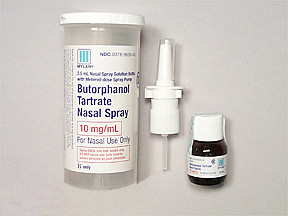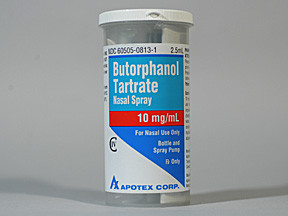BUTORPHANOL TARTRATE - NASAL
PHONETIC PRONUNCIATION: (bue-TOR-fa-nol TAR-trate)
COMMON BRAND NAME(S): Stadol NS
GENERIC NAME(S): butorphanol tartrate
Uses
USES: This medication is used to treat moderate to severe pain, including pain from surgery, muscle pain, and migraine headaches. Butorphanol is an opioid (narcotic) pain reliever similar to morphine. It acts on certain centers in the brain to give you pain relief. Butorphanol can also block the effects of opioids and can cause withdrawal symptoms in people dependent on opioids. If possible, people who have recently used opioids in high doses or for a long time should not use butorphanol. (See also Side Effects section.)
How to use BUTORPHANOL TARTRATE - NASAL
HOW TO USE: Read the Medication Guide and the Patient Information Leaflet provided by your pharmacist before you start using butorphanol and each time you get a refill. If you have any questions, ask your doctor or pharmacist. This medication is a nasal spray. Have your doctor or pharmacist show the proper way to use the nasal spray. For best results, blow your nose gently before using. Follow the patient instruction leaflet for priming the pump before first use. If the spray has not been used in 48 hours, you may need to prime the pump again before use. Use 1 spray in 1 nostril or as directed by your doctor. If you still have pain after 60-90 minutes, your doctor may direct you to use a second spray in the other nostril. If needed, butorphanol may be used again in 3-4 hours after the second spray or as directed by your doctor. Some people will need 2 sprays (1 in each nostril) at the same time. In this case, they should remain lying down because there is a higher risk of drowsiness and dizziness with this higher dose. Follow your doctor's directions carefully. The dosage is based on your medical condition and response to therapy. Do not increase the dose or use it more often than directed by your doctor. Pain medications work best if they are used as the first signs of pain occur. If you wait until the pain has worsened, the medication may not work as well. This drug can cause a drop in blood pressure, especially within the first hour after use. This can cause dizziness, lightheadedness, and fainting. To lower this risk, remain sitting or lying down after using this medication. If you use a nasal decongestant spray (e.g., oxymetazoline), the decongestant may make this pain medication work more slowly. Ask your doctor or pharmacist about using these 2 medications. If you have nausea, ask your doctor or pharmacist about ways to decrease it (such as lying down for 1 to 2 hours with as little head movement as possible). This medication may cause withdrawal reactions, especially if it has been used regularly for a long time or in high doses. In such cases, withdrawal symptoms (such as restlessness, runny nose, watering eyes, trouble sleeping, severe abdominal/muscle pain, nausea, vomiting, rapid breathing, and fast heartbeat) may occur if you suddenly stop using this medication. To prevent withdrawal reactions, your doctor may reduce your dose gradually. Consult your doctor or pharmacist for more details, and report any withdrawal reactions right away. Though it helps many people, this medication may sometimes cause addiction. This risk may be higher if you have a substance use disorder (such as overuse of or addiction to drugs/alcohol). Use this medication exactly as prescribed to lower the risk of addiction. Ask your doctor or pharmacist for more details. When used for an extended period, this medication may not work as well and may require different dosing. Talk with your doctor if this medication stops working well. Inform your doctor if your pain persists or worsens.
Side Effects
Precautions
Interactions
Overdose
Images
Reviews
Warning
WARNING: Butorphanol has a risk for abuse and addiction, which can lead to overdose and death. Butorphanol may also cause severe, possibly fatal, breathing problems. To lower your risk, your doctor should have you use the smallest dose of butorphanol that works, and use it for the shortest possible time. See also How to Use section for more information about addiction. The risk for severe breathing problems is higher when you start this medication and after a dose increase, or if you use the wrong dose/strength. Using this medication with alcohol or other drugs that can cause drowsiness or breathing problems may cause very serious side effects, including death. Also, other medications can affect the removal of butorphanol from your body, which may affect how butorphanol works. Be sure you know how to use butorphanol and what other drugs you should avoid taking with it. See also Drug Interactions section. Get medical help right away if any of these very serious side effects occur: slow/shallow breathing, unusual lightheadedness, severe drowsiness/dizziness, difficulty waking up. Keep this medicine in a safe place to prevent theft, misuse, or abuse. If someone accidentally swallows or uses this drug, get medical help right away. Before using this medication, women of childbearing age should talk with their doctor(s) about the risks and benefits. Tell your doctor if you are pregnant or if you plan to become pregnant. During pregnancy, this medication should be used only when clearly needed. It may slightly increase the risk of birth defects if used during the first two months of pregnancy. Also, using it for a long time or in high doses near the expected delivery date may harm the unborn baby. To lessen the risk, use the smallest effective dose for the shortest possible time. Babies born to mothers who use this drug for a long time may develop severe (possibly fatal) withdrawal symptoms. Tell the doctor right away if you notice any symptoms in your newborn baby such as crying that doesn't stop, slow/shallow breathing, irritability, shaking, vomiting, diarrhea, poor feeding, or difficulty gaining weight.
Disclaimer
IMPORTANT: HOW TO USE THIS INFORMATION: This is a summary and does NOT have all possible information about this product. This information does not assure that this product is safe, effective, or appropriate for you. This information is not individual medical advice and does not substitute for the advice of your health care professional. Always ask your health care professional for complete information about this product and your specific health needs.



No Reviews Yet